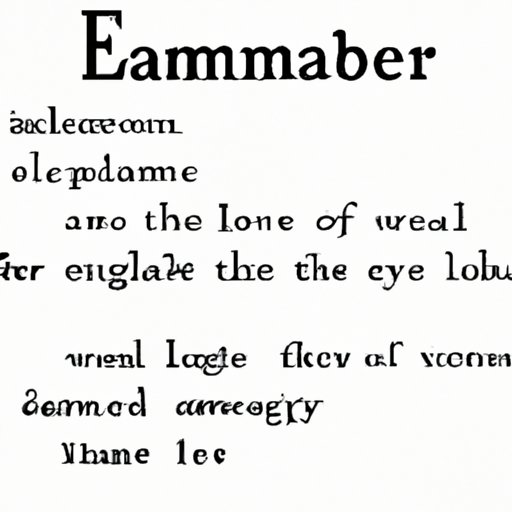Introduction
Enjambment is a poetic and literary device that is often used to great effect. It involves the continuation of a sentence or phrase beyond the end of one line of verse or text and onto another line. By using enjambment, writers are able to create a sense of momentum and movement within their writing, as well as add emphasis to certain words and ideas. In this article, we will explore the use of enjambment in literature, provide examples of its use in both poetry and prose, and offer tips for effectively employing enjambment in your own writing.
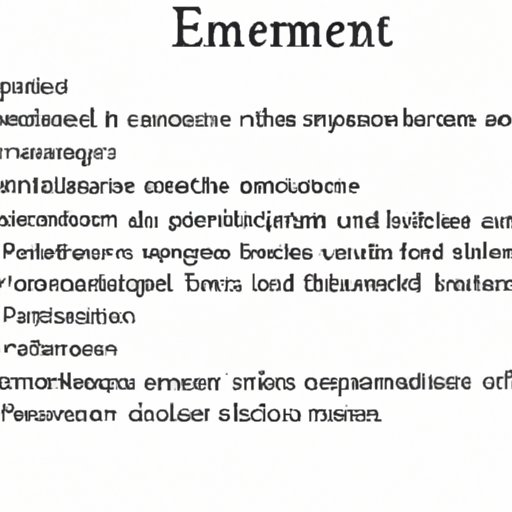
An Overview of Enjambment in Literature
Enjambment is a poetic device that has been used in literature for centuries. The term itself comes from the French word “enjamber” which means “to stride over” or “to jump over.” This refers to the way in which the writer jumps from one line of verse or prose to another without finishing the thought. By doing so, the writer is able to create a sense of momentum and movement within their writing, as well as add emphasis to certain words or ideas.
Enjambment has been used in literature since ancient times. Ancient Greek poets such as Homer and Hesiod employed enjambment in their writings, and it was also used by many Latin poets such as Virgil and Horace. In the Middle Ages, it was employed by French and Italian poets such as Dante and Petrarch, and later by English poets such as William Shakespeare and John Milton. Throughout history, enjambment has been used as a way to create rhythm and flow in a piece of writing, as well as to emphasize certain words or ideas.
Enjambment is often used in poetry to create a sense of rhythm and movement. It can also be used to emphasize certain words or ideas by allowing them to stand out from the rest of the poem. However, enjambment can also be used in prose to create a sense of continuity and movement within the writing. It can be used to draw the reader’s attention to certain words or ideas, or to help create a more fluid narrative.
Exploring the Use of Enjambment in Poetry
Enjambment is often used in poetry to create a sense of rhythm and movement. By continuing a thought or idea across multiple lines, the poet is able to create a sense of momentum and energy within their writing. This allows the poem to flow more naturally and gives it a more lyrical feel. In addition, enjambment can be used to emphasize certain words or ideas by allowing them to stand out from the rest of the poem. As Professor Charles Bressler of Purdue University states, “The enjambment creates an emphasis by allowing the reader to pause on the words, thus emphasizing their importance.”
One of the most famous examples of enjambment in poetry is William Wordsworth’s “Daffodils”. In this poem, Wordsworth uses enjambment to create a sense of momentum and energy. For example, in the first stanza he writes:
“I wandered lonely as a cloud / That floats on high o’er vales and hills”
By continuing the thought “I wandered lonely as a cloud” across two lines, Wordsworth is able to create a sense of movement and momentum within the poem. This helps to convey the feeling of loneliness and desolation that the speaker is experiencing.
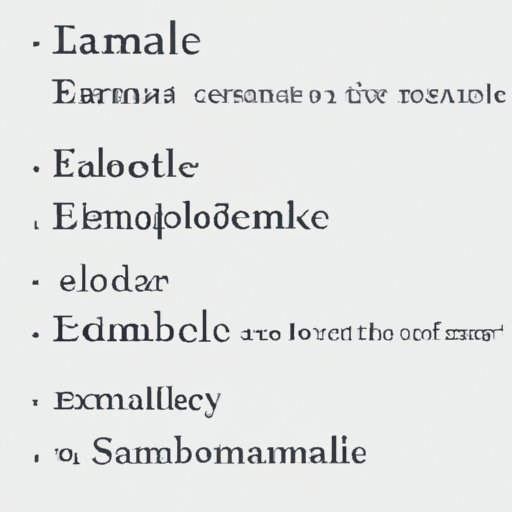
Examples of Enjambment in Literary Classics
Enjambment has been used in literature for centuries. Many of the world’s most famous authors have employed enjambment in their works, including William Shakespeare, John Milton, and Walt Whitman. Here are some examples of enjambment from these classic authors:
William Shakespeare: “But soft! What light through yonder window breaks? / It is the east and Juliet is the sun.” (Romeo and Juliet)
John Milton: “And in the lowest deep a lower deep / Still threat’ning to devour me opens wide.” (Paradise Lost)
Walt Whitman: “O Captain! My Captain! Our fearful trip is done; / The ship has weather’d every rack, the prize we sought is won.” (O Captain! My Captain!)
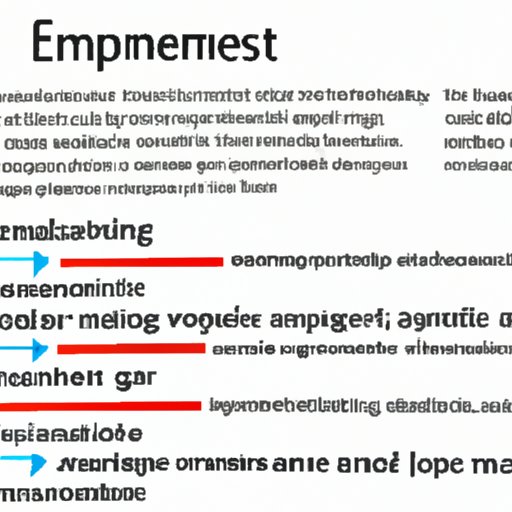
Analyzing the Effects of Enjambment in Prose
Enjambment can also be used in prose to create a sense of continuity and movement within the writing. By continuing a thought or idea across multiple sentences, the writer is able to create a sense of momentum and energy within their writing. This can help to draw the reader’s attention to certain words or ideas, as well as create a more fluid narrative. As noted by Dr. Heather L. Moore of the University of Georgia, “Enjambment is a key tool for creating a narrative flow in fiction, allowing readers to move seamlessly from one element of the story to the next.”
One of the most famous examples of enjambment in prose is F. Scott Fitzgerald’s The Great Gatsby. In this novel, Fitzgerald uses enjambment to create a sense of continuity and flow within the narrative. For example, in the opening sentence of the novel he writes:
“In my younger and more vulnerable years my father gave me some advice that I’ve been turning over in my mind ever since.”
By continuing the thought “my father gave me some advice” across two sentences, Fitzgerald is able to create a sense of continuity and flow within the narrative. This helps to draw the reader’s attention to the importance of the advice that the narrator’s father has given him.
How to Effectively Employ Enjambment in Your Writing
Enjambment can be a powerful tool for writers who want to create a sense of rhythm and flow within their writing. However, it should be used sparingly and with intention. Here are some tips for effectively employing enjambment in your writing:
- Be intentional: Make sure that you are using enjambment for a specific purpose. Ask yourself what emotion or idea you want to convey with your enjambment.
- Keep it simple: Don’t overdo it. Too much enjambment can make your writing seem forced and contrived.
- Pay attention to punctuation: Punctuation can be used to indicate the end of a thought or idea. Pay close attention to where you place your punctuation marks.
- Read your work aloud: Reading your work aloud helps to ensure that your use of enjambment is effective and natural.
In addition, here are some steps for writing with enjambment:
- Identify the emotion or idea you want to convey with your enjambment.
- Choose the words or phrases that you want to enjamb.
- Place those words or phrases at the end of the line.
- Continue the thought or idea onto the next line.
- Read your work aloud to check for effectiveness and naturalness.
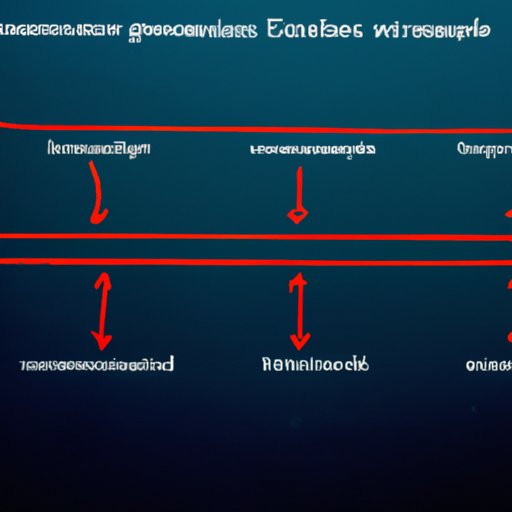
The Role of Enjambment in Enhancing Narrative Flow
Enjambment can be a powerful tool for writers who want to create a sense of continuity and flow within their writing. By continuing a thought or idea across multiple sentences, the writer is able to create a sense of momentum and energy within their writing. This can help to draw the reader’s attention to certain words or ideas, as well as create a more fluid narrative. As Professor Robert M. Scholes of Brown University explains, “Enjambment…allows writers to move quickly from one scene to another, and to link events that are widely separated in time and space.”
One of the most famous examples of enjambment used to enhance narrative flow is Ernest Hemingway’s The Old Man and the Sea. In this novel, Hemingway uses enjambment to create a sense of continuity and flow throughout the narrative. For example, in the opening paragraph he writes:
“He was an old man who fished alone in a skiff in the Gulf Stream and he had gone eighty-four days now without taking a fish.”
By continuing the thought “He was an old man who fished alone in a skiff in the Gulf Stream” across two sentences, Hemingway is able to create a sense of continuity and flow within the narrative. This helps to draw the reader’s attention to the fact that the old man has been fishing for eighty-four days without taking a fish.
A Brief History of Enjambment in Literature
Enjambment has been used in literature for centuries. From ancient Greek and Latin poets to English Romantic poets, enjambment has been a popular poetic device throughout history. It has been used as a way to create rhythm and flow in a piece of writing, as well as to emphasize certain words or ideas. In the modern era, enjambment is still widely used in both poetry and prose, and continues to be an important tool for writers who wish to create a sense of continuity and flow within their writing.
Early examples of enjambment in literature can be found in the works of Ancient Greek poets such as Homer and Hesiod. In the Middle Ages, it was employed by French and Italian poets such as Dante and Petrarch, and later by English poets such as William Shakespeare and John Milton. In the modern era, enjambment has been used by many of the world’s most famous authors, including F. Scott Fitzgerald, Ernest Hemingway, and Walt Whitman.
Conclusion
Enjambment is a powerful tool for writers who want to create a sense of rhythm and flow within their writing. By continuing a thought or idea across multiple lines or sentences, the writer is able to create a sense of momentum and energy within their writing. It can also be used to emphasize certain words or ideas by allowing them to stand out from the rest of the text. Enjambment has been used in literature for centuries, and continues to be an important tool for writers who wish to create a sense of continuity and flow within their writing.
(Note: Is this article not meeting your expectations? Do you have knowledge or insights to share? Unlock new opportunities and expand your reach by joining our authors team. Click Registration to join us and share your expertise with our readers.)
